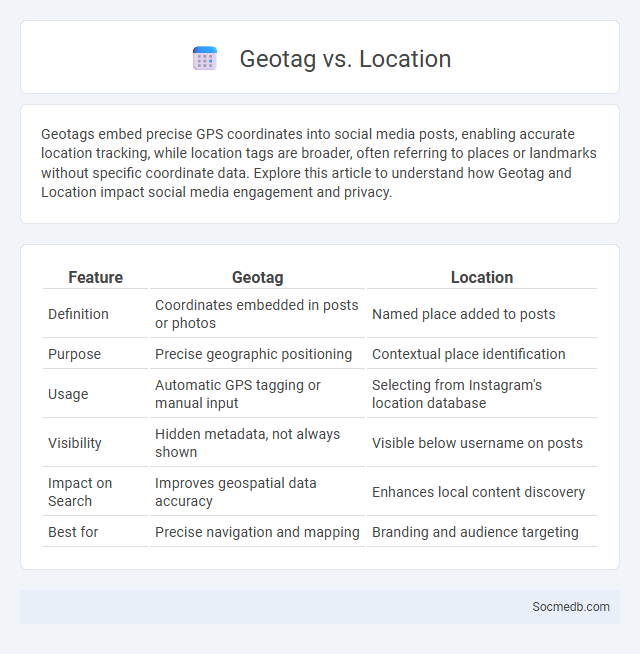
Photo illustration: Geotag vs Location
Geotags embed precise GPS coordinates into social media posts, enabling accurate location tracking, while location tags are broader, often referring to places or landmarks without specific coordinate data. Explore this article to understand how Geotag and Location impact social media engagement and privacy.
Table of Comparison
| Feature | Geotag | Location |
|---|---|---|
| Definition | Coordinates embedded in posts or photos | Named place added to posts |
| Purpose | Precise geographic positioning | Contextual place identification |
| Usage | Automatic GPS tagging or manual input | Selecting from Instagram's location database |
| Visibility | Hidden metadata, not always shown | Visible below username on posts |
| Impact on Search | Improves geospatial data accuracy | Enhances local content discovery |
| Best for | Precise navigation and mapping | Branding and audience targeting |
Understanding Geotag: Definition and Importance
Geotag is a metadata element that adds geographic information, such as latitude and longitude, to your social media posts, photos, or videos. Understanding geotags enhances content discoverability, improves engagement by connecting users with location-specific posts, and aids businesses in targeting local audiences effectively. Your use of geotags can boost social media marketing strategies by providing valuable location insights and increasing relevance to users nearby.
Location Data: What Does It Really Mean?
Location data in social media refers to the precise geographical information that platforms collect from your device, such as GPS coordinates, IP address, and Wi-Fi signals. This data enables highly targeted advertising, personalized content delivery, and real-time location sharing, but it also raises significant privacy concerns due to potential misuse or unauthorized access. Understanding how your location data is collected, stored, and utilized empowers you to manage your digital footprint and control your online privacy effectively.
Geotag vs Location: Key Differences
Geotagging embeds precise geographic coordinates such as latitude and longitude into social media posts, enabling exact location tracking and advanced search filters. Location tags, in contrast, often refer to broader, user-friendly place names like cities, landmarks, or establishments without specific coordinates. Understanding the distinction improves content discoverability and user engagement by leveraging accurate spatial metadata versus general place references.
Types of Geotagging Technologies
Geotagging technologies in social media include GPS, Wi-Fi positioning, and IP address tracking, each providing varying levels of location accuracy. GPS offers precise coordinates ideal for posts requiring exact location data, while Wi-Fi positioning enhances indoor geotagging where GPS signals falter. Your choice of geotagging method impacts the relevance and reach of your social media content by connecting it to specific geographic contexts.
How Geotags Enhance Digital Content
Geotags enhance digital content by embedding precise location data that boosts search engine optimization and increases content discoverability on social media platforms. Including geotags in posts enables better audience targeting by connecting users with location-specific interests, thereby driving engagement and relevance. Brands leveraging geotagging benefit from improved analytics on user demographics and behavior, facilitating more strategic marketing campaigns.
Location Services: How They Work and Why They Matter
Location services in social media utilize GPS, Wi-Fi, and cellular data to pinpoint users' geographic positions, enabling personalized content and targeted advertising. By integrating real-time location data, platforms enhance user engagement through localized event notifications, friend suggestions, and relevant promotions. Privacy controls are crucial, as users must manage permissions to balance convenience with data security in location-based interactions.
Comparing Geotag Precision vs General Location
Geotag precision in social media enables users to share exact coordinates, enhancing location-specific engagement and content discovery through features like check-ins and targeted ads. In contrast, general location tagging offers broader area information, such as city or neighborhood names, which sacrifices accuracy but simplifies privacy concerns and reduces user tracking sensitivity. Precision geotags significantly improve analytics for businesses by delivering detailed user movement patterns, whereas general locations promote safer, less intrusive user interactions.
Privacy Concerns of Geotag and Location Data
Geotag and location data in social media posts can expose Your precise whereabouts, increasing risks of stalking, burglary, or identity theft. Sharing location details often results in unintended data collection by third parties, compromising Your privacy and potentially leading to targeted advertising or profiling. Users must manage privacy settings carefully and consider disabling location tags to protect sensitive information from unauthorized access.
Applications of Geotagging in Social Media
Geotagging in social media enhances content discovery by associating posts, images, and videos with specific geographic locations, improving local search relevance and user engagement. Businesses leverage geotagged data to target location-based advertisements, analyze consumer behavior, and optimize marketing strategies for regional audiences. Social platforms like Instagram, Facebook, and Twitter utilize geotags to facilitate event tracking, promote local trends, and enable users to explore location-specific content seamlessly.
Choosing Between Geotag and Location: Best Practices
Choosing between geotag and location on social media depends on the desired level of visibility and privacy control. Geotags provide precise coordinates, enhancing post discoverability in local searches and improving engagement for businesses targeting specific areas. Location tags offer broader context, protecting user privacy while still associating content with general places or landmarks.
 socmedb.com
socmedb.com